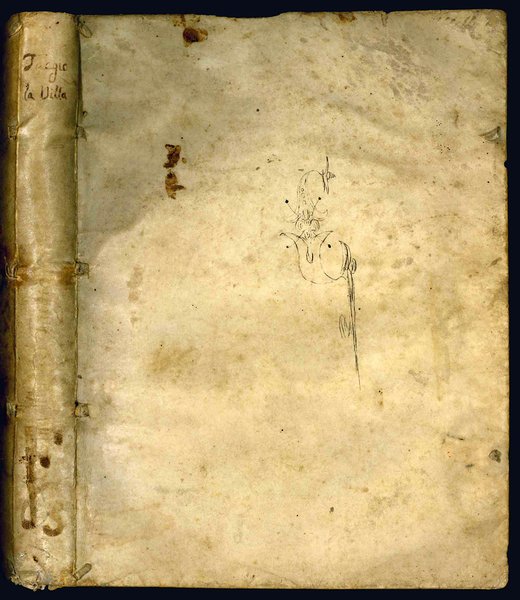
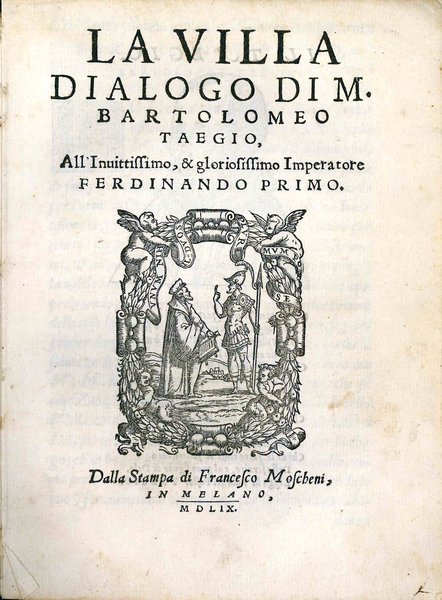
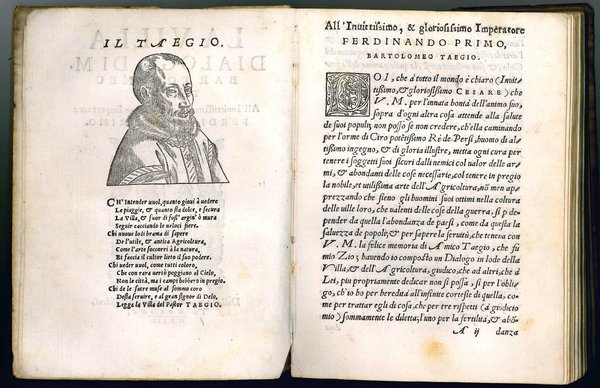
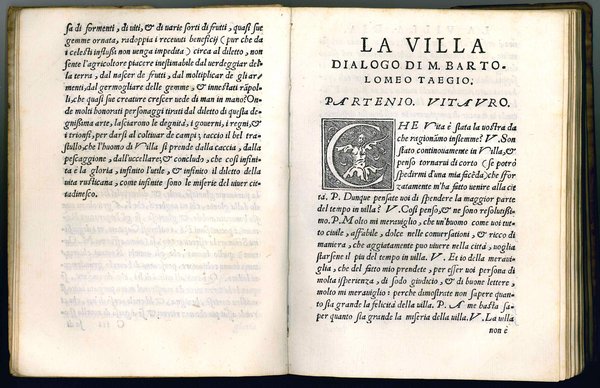
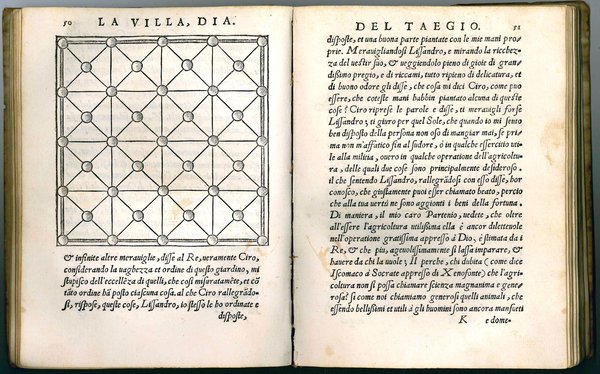
Libro
Taegio, Bartolomeo (Ca. 1520-1573)
La villa dialogo
Francesco Moscheni, 1559
non disponibile
Govi Libreria Antiquaria (Modena, Italia)
Parla con il LibraioLe corrette spese di spedizione vengono calcolate una volta inserito l’indirizzo di spedizione durante la creazione dell’ordine. A discrezione del Venditore sono disponibili una o più modalità di consegna: Standard, Express, Economy, Ritiro in negozio.
Condizioni di spedizione della Libreria:
Per prodotti con prezzo superiore a 300€ è possibile richiedere un piano rateale a Maremagnum. È possibile effettuare il pagamento con Carta del Docente, 18App, Pubblica Amministrazione.
I tempi di evasione sono stimati in base ai tempi di spedizione della libreria e di consegna da parte del vettore. In caso di fermo doganale, si potrebbero verificare dei ritardi nella consegna. Gli eventuali oneri doganali sono a carico del destinatario.
Clicca per maggiori informazioniMetodi di Pagamento
- PayPal
- Carta di Credito
- Bonifico Bancario
-
-
Scopri come utilizzare
il tuo bonus Carta del Docente -
Scopri come utilizzare
il tuo bonus 18App
Dettagli
Descrizione
4to (194x143 mm). [22], 181 [i.e. 185], [5] pp. (repeated three times in the numbering the leaves 102 and 103). Collation: A-P4Q6R-Z4 Aa-Cc4. With the printer's device on the title-page, a portrait of the author on its verso and four woodcuts in the text (two of full-page size).On the front pastedown bookplate "M. Cajrati, Milano", on the front flyleaf bookplate "Biblioteca Fagnani G." Con­­temporary limp vellum, ties lacking, manuscript title on the spine and on the lower edge, two tiny wormholes in the last two leaves carefully repaired touching two letters, last quire a bit loose, a few very light damp stains, but a very fine, fresh and genuine copy.
VERY RARE FIRST EDITION. The work presents a broad picture of the advantages of rural life in sixteenth-century Lombardy in the form of a dialogue between two gentlemen, Vitauro and Partenio. Vitauro, in whose voice can be recognized Taegio's own, maintains the superiority of rural life compared to urban life, He tries to persuade Partenio to leave Milan and settle in the country. One of the benefits Vitauro argues, of living in the countryside is the pursuit of "otium' or honorable leisure, which involves indulging in reading and writing and engaging in learned conversations without any of the distractions that are typical of the urban environment. Taegio also distances himself from both his contemporaries and predecessors by separating the villa from its agricultural context. Unlike other contemporary contributors to villa literature, such as Giuseppe Falcone and Agostino Gallo, the pleasure of villa life for Taegio does not derivate from landowner's direct involvement in agriculture, but is firmly rooted in the tradition of "vita contemplativa' that originates with the writings of Cicero and Pliny the Younger. An essential part of the pleasure of living in the country derives from the presence of gardens, e.g. the villas of Cesare Simonetta at Castellazzo and that of senator Pier Paolo Arrigoni are rendered in detail. While the latter is described in terms of the gods and goddesses to whom each plant is sacred, the description of the Simonetta's garden has the flavor of an actual visit. In the related passage describes a square and well-proportioned garden enclosed by a hedge, whose paths are neither too wide nor too narrow but such that they agree well with the delicate garden. The agreement of all the garden parts seems to be achieved by the use of geometry and proportion, which guarantee that "l'occhio al mirar non ne sente offesa alcuna" (p. 158, the eye by looking cannot see anything wrong). Taegio makes his original contribution to garden theory when he gives a well-ordered and geometric garden a new, if somewhat generic appellation. He explains that in Simonetta's garden are to be found "the ingenious grafts that show with great wonder to the world the industry of a wise gardener", who molds nature with art and therefore "fà' (pp. 160-161) a "third nature'. This is one of the most quoted passages of Taegio's treatise because it includes one of the earliest articulations of gardens as "third nature', that is, as a cultivated nature that differs both from the agricultural fields and urban infrastructure of the cultural landscape ("second nature') and from wilderness ("first nature'). The meaning of "terza natura' is that which mediates between art and nature (cf. Bartolomeo Taegio, La Villa, T. E. Beck,ed. and trans.,Philadelphia,PA, 2011,pp. 9-80).
La Villa is an exceptional document because it reflects on existing gardens and for this reason constitutes an invaluable source of information about sixteenth century villa culture in Lombardy (more than 280 villa owners and places are mentioned in the dialogue, e.g. a poetic description of the Borromeo villa "Queen of Lago Maggiore' enliven the dialogue). In the field of landscape architecture, which lacks a body of theoretical writing comparable to that of architecture, and in which a comprehensive survey of history, theory, and practice was not even attempted until the eighteenth century, La Villa is an invaluable source of theory from the Renaissance (cf. J.S. Ackerman, The Villa. Forms and Ideology of Country Houses, Princeton, NJ, 1990, pp. 108-123; andB. Basile, Bartolomeo Taegio e i giardini del Rinascimento, in: "Filologia e critica", 16/1, 1991, pp. 20-40).
Bartholomeo Taegio, jurist and man of letters, was born in Milan to an old patrician family. It is likely that he studied law at the University of Pavia and was equally well-educated in humanistic studies. Ironically, when he was in his early twenties Taegio found himself on the wrong side of the law and was banished from Milan to Novara for having committed a murder. Evidently, he wasted no time adjusting to his new surroundings. He bought land and started his own business practicing law in Novara. In 1546 he was elected to the College of Jurists of Milan and at the same time founded a semi-secret literary society called the Academy of the Shepherds of Agogna (i.e. "agognare', to desire, cover, or yearn for eagerly). It was his intention to remain in Novara and dreamed to make that city "a studious Athens, where all the liberal arts would display their splendour by competing with one another'. His vision never realized since he was constrained to leave Novara in 1554 and forced to return to Milan apparently because he attracted the attention of the Inquisition. It seems that began his career as a professional writer about the same time, starting with Le Risposte, a collection of fifty-three essays in the form of replies to inquiries from his friends, on topics as poetry, painting, music, law, friendship, hunting, solitude, etc. Cardinal Giovanni Morone appointed him governor of the territory of the Orta Lake. Taegio also served as one of the Vicars General of the State of Milan and became a member of the Collegio di Giureconsulti, a prestigious association of specialists in law at the highest level. Then he published L'Essilio, which offers a tantalizing glimpse into the author's mixed feelings about returning to Milan. In 1568 Taegio published a Latin treatise on criminal law, and in 1571/2 Il Liceo, a work on academies, nobility, the art of composing mottoes and poetical imagination, an important source on historical and biographical facts regarding Milanese literature. His last work was published in 1572, L'Ufficioso, a dialogue on works of piety and religion dedicated to Carlo Borromeo. The exact date, place and circumstances of Taegio's death remain a mystery (cf. T.E. Beck, A Critical Edition of Bartolomeo Taegio's "La Villa', Philadelphia, PA, Diss., 2001, pp. 6-13).
Edit 16, CNCE47957; Universal STC, no. 857911; P. Cottini, Giardini in Lombardia: dalle origini all'età barocca, Varese, 1994, p. 314; I. Lauterbach, The Gardens of the Milanese "Villeggiatura' in the Mid-Sixteenth Century, in: "The Italian Garden: Art, Design and Culture", J.D. Hunt, ed., Cambridge, 1996, pp. 152-159) C. Lazzaro, The Italian Renaissance Garden: From the Conventions of Planting, Design, and Ornament to the Grand Gardens of Sixteenth-Century Central Italy, New Haven, CT e London, 1990, pp. 9-10; C. Mazzanelli, L'antico regime in villa. Con tre testi milanesi, Rome, 2004, pp. 49-162.
In 4to (mm 194x143). Pp. [22], 181 [i.e. 185], [5]. Ripetute per tre volte nella numerazione le cc. 102 e 103. Segnatura: A-P4 Q6 R-Z4 Aa-Cc4. Con il ritratto dell'autore inciso in legno al verso del frontespizio e 4 illustrazioni xilografiche nel testo, 2 delle quali a piena pagina. Marca tipografica al titolo. Al contropiatto ex-libris M. Cajrati, Milano e sul risguardo libero anteriore etichetta stampata Biblioteca Fagnani G. Pergamena floscia coeva con nervi passanti, titolo manoscritto al dorso e sul taglio inferiore, piccolo disegno a penna sul piatto anteriore (mancano i legacci, lievi mancanze marginali, qualche macchia). Due piccoli fori abilmente restaurati che coinvolgono il piatto posteriore della legatura, il risguardo libero posteriore e le ultime due carte di testo con minima perdita di parte di due lettere, ultimo fascicolo un po' sciolto, qualche lieve fioritura marginale, ma ottima copia fresca e marginosa.
.
